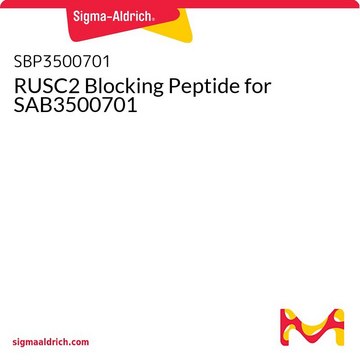HMT-3522 S1
98102210, human breast, Epithelial-like
Anmeldenzur Ansicht organisationsspezifischer und vertraglich vereinbarter Preise
Alle Fotos(1)
About This Item
UNSPSC-Code:
41106514
Empfohlene Produkte
Produktbezeichnung
HMT-3522 S1, 98102210
Biologische Quelle
human breast
Wachstumsmodus
Adherent
Karyotyp
45,XX,1p-,-6,8q+-,12p+,14q+,17q+
Morphologie
Epithelial-like
Produkte
Not specified
Rezeptoren
EGF
Methode(n)
cell culture | mammalian: suitable
Relevante Krankheit(en)
cancer
Versandbedingung
dry ice
Lagertemp.
−196°C
Ursprung der Zelllinie
Human Caucasian breast epithelial
Beschreibung der Zelllinie
HMT-3522 S1, also known as HMT-3522/wt, is a subline that has been derived from HMT-3522. The parent line was established from a benign breast tumour of a 48 year old woman and has undergone spontaneous malignant transformation. It was grown on collagen in serum-free media without antibiotics from explantation onwards. A mutation at codon 179 of the p53 gene was detected during establishment of the parent line. HMT-3522 S1 is a continuation of this line from passage 34 growing without collagen. Subline S2 (Sigma catalog no. 98102211) has been isolated by culturing S1 cells from passage 118 in serum-free media without epidermal growth factor (EGF). The third subline, T4-2 (Sigma catalog no. 98102212) was established from S2 at passage 238 and is the only tumorigenic line in nude mice out of the 3 sublines. S2 and T4-2 grow on collagen-coated flasks. HMT-3522 S1 is near-diploid, but an evolution of karyotype has been observed by regular chromosomal analyses. The expression of cytokeratin 13, 14, 17 and 18 and vimentin has been reported. Expression of EGF-R, c-erb-B2, N-myc, c-ras-Ha1, c-ras-Ki2 and N-ras was shown to fluctuate slightly with passage number. The cells have tested negative for estrogen receptor, c-erbA1, c-erb-A2, int-2 or hst-1. During propagation growth factor requirements decreased simultaneously with amplification and overexpression of c-myc protooncogene. In a three-dimensional basement membrane culture assay the phenotypic characteristics of normal breast tissue in vivo are recapitulated. This cell line has remained non-tumorigenic for more than 400 passages. Publications using this cell line must refer to the original paper. Any sublines created must include the name HMT-3522 in the designation, but a short name may be used in the same paper.
DNA-Profil
Not specified
Nährmedium
DMEM / Ham′s F12 (1:1) + 2 mM Glutamine + 250 ng/ml insulin + 10 μg/ml transferrin +10E-8M sodium selenite + 10E-10M 17 beta-estradiol + 0.5 μg/ml hydrocortisone + 5 μg/ml ovine prolactin + 10 ng/ml EGF
Subkultur-Routine
If starting from a frozen ampoule the cryoprotectant should be removed. Add thawed cells to a conical based centrifuge tube e.g. 15 ml tube; slowly add 4 ml of culture medium to the tube. Take a sample of the cell suspension, e.g. 100 ul, to count cells. Centrifuge the cell suspension at low speed, i.e., 100-150 x g for a maximum of 5 minutes.Split subconfluent cultures using 0.25% trypsin or trypsin/EDTA; 5% CO2; 37 °C. Seed pre-coated flasks at 2-4 x 10, 000 cells/cm2. Cells detach slowly; add same volume of trypsin inhibitor as trypsin used, centrifuge and reseed cells in collagen IV coated flasks. Medium is serum-free, therefore trypsin inhibitor is essential. S1cells can be slow in spreading out after subculture and may take 2-3 days to attach. Good growth occurs 5-7 days after subculture.
Cells should be frozen in (45% conditioned media: 45% fresh media) with 10% DMSO.
Cells should be frozen in (45% conditioned media: 45% fresh media) with 10% DMSO.
Sonstige Hinweise
Additional freight & handling charges may be applicable for Asia-Pacific shipments. Please check with your local Customer Service representative for more information.
Hier finden Sie alle aktuellen Versionen:
Analysenzertifikate (COA)
Lot/Batch Number
It looks like we've run into a problem, but you can still download Certificates of Analysis from our Dokumente section.
Wenn Sie Hilfe benötigen, wenden Sie sich bitte an Kundensupport
Besitzen Sie dieses Produkt bereits?
In der Dokumentenbibliothek finden Sie die Dokumentation zu den Produkten, die Sie kürzlich erworben haben.
Unser Team von Wissenschaftlern verfügt über Erfahrung in allen Forschungsbereichen einschließlich Life Science, Materialwissenschaften, chemischer Synthese, Chromatographie, Analytik und vielen mehr..
Setzen Sie sich mit dem technischen Dienst in Verbindung.
